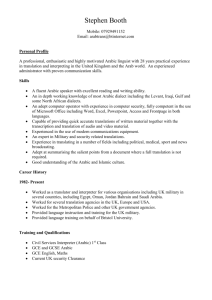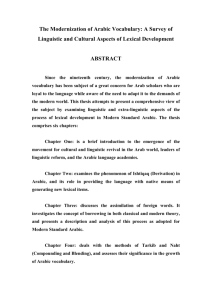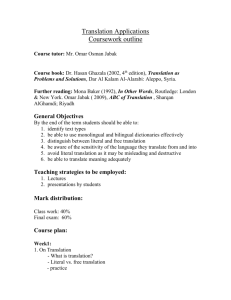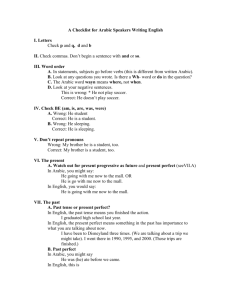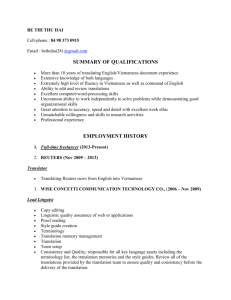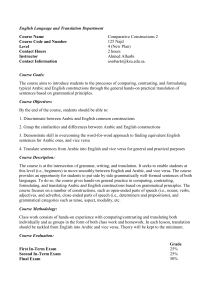Articles Published - Applied Science University
advertisement
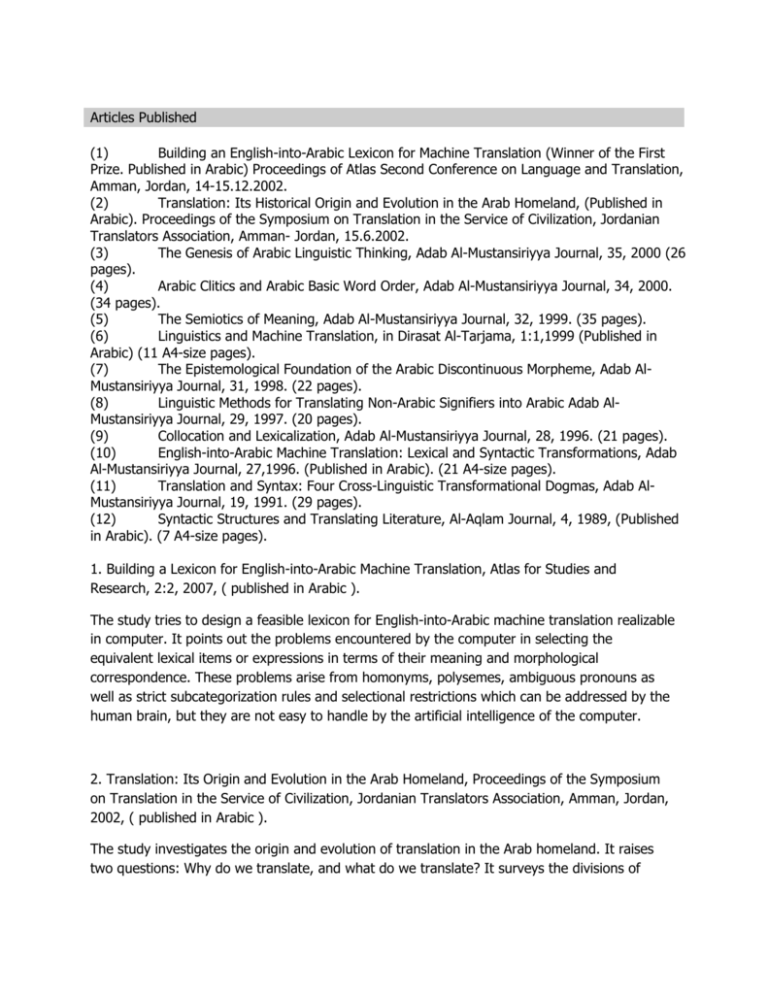
Articles Published (1) Building an English-into-Arabic Lexicon for Machine Translation (Winner of the First Prize. Published in Arabic) Proceedings of Atlas Second Conference on Language and Translation, Amman, Jordan, 14-15.12.2002. (2) Translation: Its Historical Origin and Evolution in the Arab Homeland, (Published in Arabic). Proceedings of the Symposium on Translation in the Service of Civilization, Jordanian Translators Association, Amman- Jordan, 15.6.2002. (3) The Genesis of Arabic Linguistic Thinking, Adab Al-Mustansiriyya Journal, 35, 2000 (26 pages). (4) Arabic Clitics and Arabic Basic Word Order, Adab Al-Mustansiriyya Journal, 34, 2000. (34 pages). (5) The Semiotics of Meaning, Adab Al-Mustansiriyya Journal, 32, 1999. (35 pages). (6) Linguistics and Machine Translation, in Dirasat Al-Tarjama, 1:1,1999 (Published in Arabic) (11 A4-size pages). (7) The Epistemological Foundation of the Arabic Discontinuous Morpheme, Adab AlMustansiriyya Journal, 31, 1998. (22 pages). (8) Linguistic Methods for Translating Non-Arabic Signifiers into Arabic Adab AlMustansiriyya Journal, 29, 1997. (20 pages). (9) Collocation and Lexicalization, Adab Al-Mustansiriyya Journal, 28, 1996. (21 pages). (10) English-into-Arabic Machine Translation: Lexical and Syntactic Transformations, Adab Al-Mustansiriyya Journal, 27,1996. (Published in Arabic). (21 A4-size pages). (11) Translation and Syntax: Four Cross-Linguistic Transformational Dogmas, Adab AlMustansiriyya Journal, 19, 1991. (29 pages). (12) Syntactic Structures and Translating Literature, Al-Aqlam Journal, 4, 1989, (Published in Arabic). (7 A4-size pages). 1. Building a Lexicon for English-into-Arabic Machine Translation, Atlas for Studies and Research, 2:2, 2007, ( published in Arabic ). The study tries to design a feasible lexicon for English-into-Arabic machine translation realizable in computer. It points out the problems encountered by the computer in selecting the equivalent lexical items or expressions in terms of their meaning and morphological correspondence. These problems arise from homonyms, polysemes, ambiguous pronouns as well as strict subcategorization rules and selectional restrictions which can be addressed by the human brain, but they are not easy to handle by the artificial intelligence of the computer. 2. Translation: Its Origin and Evolution in the Arab Homeland, Proceedings of the Symposium on Translation in the Service of Civilization, Jordanian Translators Association, Amman, Jordan, 2002, ( published in Arabic ). The study investigates the origin and evolution of translation in the Arab homeland. It raises two questions: Why do we translate, and what do we translate? It surveys the divisions of translation, e.g. translation proper, simultaneous interpretation, consecutive interpretation, onsight translation. According to the Old Testament, traces of translation go as back as the Babylonian era. In the early Islamic an Abbasid Period translation activities may be divided into two stages, each with its prominent translators. The study then moves to translation activities in the modern time and surveys the role of Arabic language academies in steering translation and in determining and disseminating scientific terms translated by these academies. 3. The Genesis of Arabic Linguistic Thinking, Adaab Al-Mustansiriyya, 35, 2000. The question of the origins and evolution of Arabic linguistic thinking rests on whether Arabic linguistics was or was not influenced by Greek ( and perhaps Syriac ) linguistic methodology. There is little evidence of Greek influence on the origins of Arabic linguistic thinking. Versteegh (1977) contends that Greek linguistic and philosophical influence is more transparent in the later development of Arabic linguistics than in its origins. 4. Arabic Clitics and Arabic Basic Word Order, Adaab Al-Mustansiriyya, 34, 2000. Arabic basic word order can not be determined without thoroughly observing and describing a number of phenomena the outstanding of which are a. the behavior of the obligatory mnemonic third person and plural clitics, which are affixed to the verb and which are conditioned by the word orders SV and VS. b. the position of pronominal object clitics in relation to the position of the verb. c. the word order of the embedded sentence in the complex sentence, which is determined by the complementizer that introduces the embedded sentence. d. pragmatic factors and discourse structure. 5. Linguistics and Machine Translation, Diraasaat Al-Tarjama, 1 , 1999, also published simultaneously in Adaab Al-Mustansiriyya, 33, 1999, ( published in Arabic ). Machine translation means replacing the human brain by the computer in performing translation from one language into another. In order for the computer to accomplish this enterprise it has to be provided with five types of knowledge and competence: (1) the linguistic system of the source language, (2) the world of the source language (knowledge, beliefs, esthetic values, etc.), (3) the linguistic system of the receptor language, (4) the world of the receptor language (knowledge, beliefs, esthetic values, etc.), (5) an available feasible computer program that can handle the linguistic systems of the two languages involved in translation. 6. The Epistemological Foundation of the Arabic Discontinuous Morpheme, Adaab AlMutansiriyya, 31, 1998. The controversy on whether the gerund is derived from the past tense verb or the past tense verb is derived from the gerund goes back to the eighth century. The Basra School of Grammar contends that the verb is derived from the gerund, whereas the Kufa School of Grammar contends that the gerund is derived from the verb. The reason for this controversy rests on the fact that Arabic derivation is accomplished by patterns rather than by affixation as is the case in English. An experiment on 40 subjects who are native speakers of Arabic was made in this respect. 65.5% of the subjects’ responses elicited that the gerund is derived from the verb. 7. The Semiotics of Meaning, Adaab Al-Mustansiriyya, 32, 1998. Meaning is either verbal or nonverbal, or an amalgam of both. It is either human or nonhuman (meaning of animal signs). Human verbal meaning is a function of an aggregate of the semiotics of interactive and interpenetrative linguistic and nonlinguistic systems and modes of representation which include linguistic meaning (meaning encoded by the morphological, syntactic, and phonological modules), acquired knowledge of the world, concomitant paralinguistic (vocal and kinesic) modes of representation, knowledge of the meaning of lexical items, beliefs, taste, habits, and emotions. 8. Linguistic Methods for Translating Non-Arabic Signifiers into Arabic, Adaab Al-Mustansiriyya, 29, 1997. A meticulous examination shows that Arabic employs nine methods for forming signifiers (linguistic sound images) to label those signifieds (concepts) which originally are not the product of the Arab mind and culture. Within the method of translating by loanblend four patterns are used, and within the method of translating by calque six patterns are used. The easiest and most familiar among these methods is, par excellence, translating by loanwords. 9. Machine Translation from English into Arabic: Cross-linguistic Lexico-syntactic Transformations, Adaab Al-Mustansiriyya, 27, 1996, ( published in Arabic ). Machine translation is a cross-linguistic transformational process undertaken by the computer. A linguistic mathematical formula is required to make translation by the computer realizable. The linguistic models followed in this study are Chomsky’s Transformational-Generative Grammar and Fillmore’s Case Grammar. An English science text was selected and an English-into-Arabic lexico-syntactic program was linguistically formulated and then was converted into a computer program. The results of the experiment have shown that the syntactic rules were constant when the lexical items were altered. 10. Collocation and Lexicalization, Adaab Al-Mustansiriyya, 28, 1996. Lexical items in any natural language select other lexical items in the formation of sentences on two bases: logical and arbitrary. The former is a property of universal semantic rules applicable to any natural language. The latter is a property of both semantics and pragmatics where the latter overrides the former and is assumed to be culture-specific. It is the latter which is arbitrary and hence recalcitrant to systematization within a single language or across languages. 11. Syntactic Structures and Literature Translation, Al-Aqlaam, 4, l989, ( published inArabic). The syntax of the sentences of novels,dramas,and especially of poems, is often manipulated to achieve certain semantic and phonological effects. In poetry, for example, the syntax is manipulated to achieve rhyme and rhythm. Each language has its own set of categorial and transformational rules, some of which are lacked by other languages. For example, English rules of agentive passive and extraposition are lacked by Arabic. Verbless simple sentences can be constructed in Arabic, in English they can not. Such syntactic differences are crucial in translating literature. 12. Translation and Syntax Four Cross-linguistic Transformational Dogmas, Adaab AlMustansiriyya, 19, 1989. A cogent analysis of two cognate or noncognate languages shows that syntactic differences among natural languages can be classified under the two subcomponents of syntax: categorical rules and transformational rules. Cross-linguistic transformational rules are either obligatory or optional. The four syntactic processes needed in translating between any two languages are permutation, insertion, deletion , and substitution. Art and Literary Essays and Critiques Published in Arabic in Iraqi Magazines. (1) Gilgamesh, Lolita, and Hekilbery Fin (translation), Al-Thaqafa Al-Ajnabiyya, 3:1993. (2) The Mortal Wordsworth and His Philosophy of Immortality, Afaq Arabiyya, 1:1976. (3) Field Study of Handicraft Training Center of the Iraqi Ministry of Education, AlTurath Al-Sha’bi, 3:1973. (4) Stories: Study and Analysis, Al-Turath Al-Sha’bi, 10:1972. (5) The Art of Inlay on Wood, Al-Turath Al-Sha’bi, 9:1972. (6) Polish Contemporary Rugs Exhibition in Baghdad, Al-Turath Al-Sha’bi, 8:1972. (7) Soviet Folk Handicrafts Exhibition in Baghdad, Al-Turath Al-Sha’bi, 5-6 : 1972. (8) Engraving on Wood, Al-Turath Al-Sha’bi, 9:1971. (9) Heroic Life Pattern in the Legend (Part two), Al-Turath Al-Sha’bi, 5-6:1971. (10) Field Study of Folk Handicrafts in Karbala’ and Babel, Al-Turath Al-Sha’bi, 3: 1971. (11) The Swan Lake Ballet, Al-Turath Al-Sha’bi, 2:1971. (12) Handicrafts in Wasit Governorate, Al-Turath Al-Sha’bi, 1:1970. (13) Heroic Life Pattern in the Legend (Part one), Al-Turath Al-Sha’bi, 4:1970. (14) A Tale and Music: A Study of the Symphony Scheherazade, Al-Turath Al-Sha’bi, 2-3, 1970. (15) Arab Costumes, Al-Turath Al-Sha’bi, 1:1970. Art Essays Published in English (1) (2) (3) December Contemporary Iraqi Folk Tapestries, Baghdad Observer, January 22, 1973. Notes on Identically-Delivered Motifs, Baghdad Observer, December 18,1972. Babylonian Embellishments of the Throne Hall Façade, Baghdad Observer, 1,1972.


